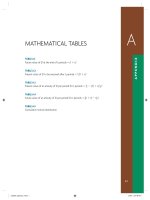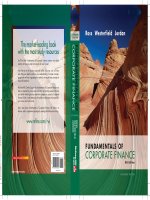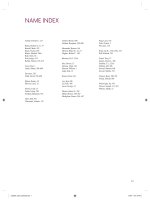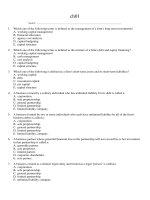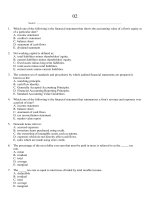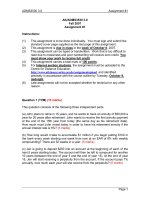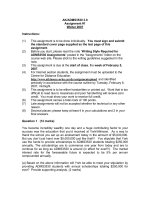exam solution fundamentals of corporate finance, 4th edition brealey
Bạn đang xem bản rút gọn của tài liệu. Xem và tải ngay bản đầy đủ của tài liệu tại đây (179.45 KB, 12 trang )
Name ___________________________
Section _____ ID # ______________________
(Prof. Alagurajah’s sections F and G; Prof. King’s section D; Prof. Li’s section A; Prof. Tahani’s
sections C and E; Prof. Tissenbaum’s sections B and H)
AK/ADMS 3530 Midterm Exam
Fall 2007
October 21, 2007
Exam - Solutions
This exam consists of 30 multiple choice questions and carries a total of 100 points. Choose the
response which best answers each question. Circle your answers below, and fill in your
answers on the bubble sheet. Only the bubble sheet is used to determine your exam score.
Please note the following points:
- Read the questions carefully and use your time efficiently
- The 20 “Numerical Questions” are worth 4 points each.
- The 10 “Conceptual Questions” are worth 2 points each.
- Choose the answers that are closest to yours, because of possible rounding.
- Keep at least 2 decimal places for dollar amounts in your calculations, and at least 6
decimal places for interest rates.
- Interest rates are annual unless otherwise stated.
- Bonds pay semi-annual coupons unless otherwise stated and have a face value (or par
value) of $1,000.
- You may use the back of the exam paper as your scrap paper.
Numerical Questions (4 points each)
1. (Q. 6 in B) You decide to sell your car and a friend has offered you $1,000 now and
four annual payments of $2,000, with the annual payments starting at the end of the
second year. Your other option is to sell the car to a dealer today for $7,000.
Assuming your friend will not default on the payments and the market interest rate is
8%, should you sell your car to your friend?
A)
B)
C)
D)
Yes; present value is $7,134
Yes; present value is $7,624
No; present value is $6,134
No; present value is $6,624
Solution A
The PV of the annuity payment of $2,000 for 4 years is:
PV(at t=1) = 2,000 x PVIFA(8%,4) = 6,624.25
PV(at t=0) = 6,624.25/ (1.08) = 6,133.56
Finally add the initial payment $1000 today to the PV annuity at t=0
6,133.56 + 1,000 = 7,133.56 = $7,134
Page 1
This is more than the $7,000 you would get today from the dealer. Therefore you
would sell your car to you friend.
2. (Q. 7 in B) Your brother bet the Toronto Maple Leafs would win their 2007 home
opener and is now trying to pay off a gambling debt of $3,000. You have agreed to
pay off the debt for him today, and in return he has agreed to pay you $125 per
month over the next three years with payments beginning immediately. What is the
effective annual interest rate you are charging him?
A)
B)
C)
D)
25.14%
32.61%
35.15%
42.24%
Solution C
3,000 = 125 x PVIFA(i,36) x (1+i) because it is an annuity due
Solve for i using your financial calculator: i = 2.5416%
EAR = (1 + im )m -1 = (1.025416)12 -1 = 35.15%
3. (Q. 8 in B) The following cash flows have a present value of $1,922.51: $300 today,
$400 at the end of year one, X at the end of year two, and $900 at the end of year
three. The annual interest rate is 6%. What is X?
A)
B)
C)
D)
$419
$450
$489
$550
Solution D
Bring all cash flows to t=0:
1,922.51 = 300 + 400/(1.06)+ X/(1.06)2 + 900/(1.06)3
1,622.51 = 377.36 + X/(1.06)2 + 755.66
X/(1.06)2 = 489.49
X = 489.49 x (1.06)2 = 549.99 or $550
4. (Q. 9 in B) You are tired of the rising housing prices in Toronto and you have
decided to move to Newfoundland and buy an ocean front property which costs
$175,000. You have enough funds for a 20% down payment and you will obtain a
25-year, fixed rate mortgage at 7.50% (APR semi-annually compounded) for the
rest. Assuming that monthly payments begin in one month, what will be your monthly
payment?
A) $1,000.00
Page 2
B) $1,024.18
C) $1,115.36
D) $1,280.87
Solution B
The mortgage is on $175,000 x 80% = $140,000
The monthly interest rate is given by:
(1 + im )12 = 1 + EAR = (1 + 3.75%)² = 1.0764063, that is im = 0.615453%
140,000 = PMT x PVIFA(0.615453%,300)
PMT = $1,024.18
5. (Q. 10 in B) If $300,000 is borrowed for a home mortgage at a posted rate of 7%
(APR semi-annually compounded), how much interest can be saved over the life of
the mortgage by agreeing to a 20-year amortization period, rather than a 25-year
amortization period?
A)
B)
C)
D)
$23,400
$62,800
$76,471
$80,715
Solution C
The monthly interest rate is given by:
(1 + im )12 = 1 + EAR = (1 + 3.5%)² = 1.0712250, that is im = 0.5750%
The monthly payment for the 20-year loan
300,000 = PMT x PVIFA(0.5750%,240)
PMT = $2,307.92
Total interest paid with the 20-year loan:
240 x 2,307.92 – 300,000 = $253,900.80
The monthly payment for the 25-year loan
300,000 = PMT’ x PVIFA(0.5750%,300)
PMT’ = $2,101.24
Total interest paid with the 25-year loan:
300 x 2,101.24 – 300,000 = $330,372.00
Difference in total interest paid: $330,372.00 - $253,900.80 = $76,471.20
6. (Q. 1 in B) Which investment would you prefer: an account offering 10.20% APR
with weekly compounding (there are 52 weeks in a year), and an account yielding
10.25% APR with quarterly compounding?
Page 3
A)
B)
C)
D)
10.20% APR with weekly compounding
10.25% APR with quarterly compounding
You would be indifferent
None of the above
Solution A
The EAR corresponding to a 10.20% APR with weekly compounding is:
0.1020 52
EAR 1 = (1 +
) − 1 = 10.7273%.
52
The EAR corresponding to a 10.25% APR with quarterly compounding is:
0.1025 4
EAR 2 = (1 +
) − 1 = 10.6508%.
4
Since the EAR corresponding to an APR of 10.20% with weekly compounding
is higher, you would prefer this investment.
7. (Q. 2 in B) What is the present value of an 8-year annuity of $750 annually if the first
payment on this annuity is to be made 3 years from today? The interest rate is 7%
per year.
A)
B)
C)
D)
$3,655.77
$3,911.67
$4,185.49
$4,478.47
Solution B
This is an ordinary annuity delayed for two years.
1
1
$750 × [
]
−
0.07 0.07 × (1.07 8 )
PV =
= $3,911.67.
(1.07 2 )
8. (Q. 3 in B) Compute the present value of the following set of payments for two years:
payments of $500 per quarter for the first year and payments of $600 per quarter
during the second year. The APR is 9% with monthly compounding and payments
will begin 3 months from today.
A)
B)
C)
D)
$3,966.84
$3,975.71
$4,116.69
$4,161.51
Solution A
0.09 12
EAR = (1 +
) − 1 = 9.3807%.
12
The corresponding quarterly interest rate is:
Page 4
rquarter = (1 + EAR )1 / n − 1 = (1 + 0.093807)1 / 4 − 1 = 2.2669%.
PV = $500 × [
$600 × [
1
1
−
]+
2.2669% 2.2669% × (1 + 2.2669%) 4
1
1
−
] /(1 + 9.3807%) = $3,966.84.
2.2669% 2.2669% × (1 + 2.2669%) 4
9. (Q. 4 in B) You are indifferent between the following two payment options: 1) pay
$15,000 cash today, or 2) pay $250 monthly over the next 2 years with the first
payment starting immediately, plus a final payment ($FP) to be made 3 years from
today. An APR of 8.4% is quoted with monthly compounding. How much is FP?
A)
B)
C)
D)
$9,456.06
$9,494.60
$12,155.45
$12,204.99
Solution C
8.4%
rmonth =
= 0.7%.
12
PV = $250 × (1 + 0.7%) × [
1
1
$ FP
−
= $15,000
]+
24
0.7% 0.7% × (1 + 0.7%)
(1 + 0.7%) 36
∴ $ FP = $[15,000 − 250 × (1 + 0.7%) × (
1
1
−
)] × (1 + 0.7%) 36
0.7% 0.7% × (1 + 0.7%) 24
= $12,155.45.
The above result still holds when we use the EAR rather the monthly interest rate
to discount the last payment $FP.
10. (Q. 5 in B) You are planning to make a purchase worth $1 million in 9 years. To
meet this goal, you need to draw up a savings plan. The problem is that you won’t
be able to make any deposit towards this savings goal in Years 3 and 7 from now.
How much is the equal amount that you have to deposit at the end of each year over
the 9 years to come (other than Years 3 and 7) in order to finance your planned
purchase? The interest rate is 7.8% compounded annually.
A)
B)
C)
D)
$80,750.66
$103,601.18
$104,931.79
$105,938.94
Solution B
Page 5
These deposits are a 9-year ordinary annuity with two missing cash flows that
occur at the end of Years 3 and 7. The future value of these cash flows can be
calculated as:
(1 + 0.078) 9 − 1
$1,000,000 = $D × [
] − $D × (1.078 6 ) − $D × (1.078 2 )
0.078
= $D × (12.3838 − 1.5693 − 1.1621) = $D × 9.6524
$1,000,000
∴ $D =
= $103,601.18.
9.6524
11. (Q. 14 in B) How much should you pay for a $1,000-face value bond with 10%
coupon, semi-annual payments, and five years to maturity if the interest rate is 12%?
A)
B)
C)
D)
$926.40
$981.40
$1,000.00
$1,075.82
Solution A
Price = $50 x PVIFA(6%,10) + $1,000 x (1.06)-10 = $926.40
12. (Q. 15 in B) If you purchase a three-year, 9% coupon bond for $950 today, how
much could it be sold for two years later if interest rates are expected to remain
stable over the next two years?
A)
B)
C)
D)
$964.95
$981.52
$1,000.00
$1,033.17
Solution B
The market interest rate is given by:
$950 = $45 x PVIFA(i,6) + $1,000 x (1+i)-6
i = 5.5009%
Two years later, there will be only 2 coupons left, the price will be:
Price = $45 x PVIFA(5.5009%,2) + $1,000 x (1+i)-2 = $981.52
13. (Q. 11 in B) What is the yield to maturity of a bond with the following characteristics?
Coupon rate is 8% with semi-annual payments, current price is $960, three years
until maturity.
A) 4.7826%
Page 6
B) 5.4867%
C) 9.5652%
D) 9.7939%
Solution C
$960 = $40 x PVIFA(i,6) + $1,000 x (1+i)-6
i = 4.7826%
YTM = 2 x i = 9.5652%
14. (Q. 12 in B) A government bond carries a 6% coupon rate, pays semi-annual
coupons, and has a $1,000 face value. If you purchase it today at $1,015 and expect
to sell it 4 years from now at $1,040, what would be your annual rate of return if the
coupons are reinvested at 4% APR semi-annually compounded?
A)
B)
C)
D)
3.1654%
6.3309%
6.9579%
27.8314%
Solution B
4-year Rate of Return = [30 x FVIFA(2%,8) + 1,040 – 1,015] / 1,015 = 27.8314%
The annual rate of return is (1+27.8314%)1/4 – 1 = 6.3309%
15. (Q. 13 in B) What is the coupon rate on a 6-year bond, paying semi-annual coupons,
with a $1,000 face value and selling at $1,050 if the yield to maturity is 4%?
A)
B)
C)
D)
2.4728%
4.0478%
4.9456%
4.9538%
Solution C
$1,050 = PMT x PVIFA(2%,12) + $1,000 x (1+i)-12
PMT = $24.7280
Cpn rate = 4.9456%
16. (Q. 19 in B) ABC Corp. has just paid a $5 per share dividend. The dividend is
projected to grow at 5% per year indefinitely. If the stock sells today for $65.625,
what is the required rate of return on ABC stock?
A) 6.25%
B) 6.75%
C) 13%
Page 7
D) 13.5%
Solution C
P0 = D1/(r - g) rearranging the formula we get r = D1/P0 + g
where D1 = D0 x (1+g) = $5 x (1+ 0.05) = $5.25; P0 = $65.625; g = 5%
r = $5.25/$65.625 + 0.05
r = 13%
17. (Q. 20 in B) DEF corp. has just paid a $2 per share dividend. The dividend is
projected to grow at 3% per year indefinitely. If the required rate of return on the
stock is 9%, then by what percentage does P1 exceed P0?
A)
B)
C)
D)
2%
3%
5.25%
9%
Solution B
Note that (P1 – P0) / P0 = (D2 - D1) / D1= g = 3%.
One can also compute the prices and their relative difference:
The price P0 today
P0 = D1/(r - g)
= $2 × 1.03 / (0.09 - 0.03)
= $2.06 / 0.06
= $34.33 per share
The price P1 in one year
P1 = D2/(r - g)
P1 = D2/(r - g) = ($2.06 × 1.03) / (0.09 - 0.03) = $35.36 per share
% increase = (P1 – P0) / P0 = ($35.6 - $34.33) / $34.33 = 3%
18. (Q. 16 in B) The next year expected EPS (earnings per share) of JKL corp. is $5;
with a dividend payout ratio of 30%, a discount rate of 16%, and a return on equity
(ROE) of 20%. What is the current stock price?
A)
B)
C)
D)
$60
$65
$70
$75
Solution D
Page 8
The next dividend will be $5 × 0.30 = $1.50 per share. The plowback ratio is 0.70
implying a growth rate g of:
g = Plowback Ratio × ROE = 0.70 × 20% = 14%
From the dividend growth model, the price of a share is:
Div1
$1.50
P0 =
=
= $75
r − g .16 − .14
19. (Q. 17 in B) The dividends of XYZ corp. are forecasted to grow at 20% per year for
two years, after which the shares grow at a fixed rate of 6% forever. If the discount
rate is 15% and a dividend of $2.50 was just paid, what should be the current share
price?
A)
B)
C)
D)
$31.16
$33.23
$37.42
$47.77
Solution C
$2.50 × 1.20 $2.50 × (1.20) 2
1
$2.50 × (1.20) 2 × (1.06)
P0 =
+
+
×
1.15
0.15 − 0.06
(1.15) 2
(1.15) 2
$3.00 $3.60
$3.816
P0 =
+
+
2
1.15 (1.15)
(1.15) 2 × 0.09
P0 = $37.42
20. (Q. 18 in B) XYZ Inc. reinvested 30% of its earnings in the corporation. The stock
sells for $25 today, and the next dividend will be $1.25 per share. The discount rate
is 7.5%. What is the rate of return on XYZ Inc. equity (ROE)?
A)
B)
C)
D)
7.50%
8.33%
12.5%
22.5%
Solution B
Page 9
We know that P0= D1/(r-g)
Therefore g = r - D1 / P0
Or g = 0.075 - 1.25/25 = .025 or 2.5%
We also know that g = ROE x Plowback Ratio
Or ROE = g / Plowback Ratio
Therefore ROE = 0.025 / 0.3 = 0.0833 or 8.33%
Page 10
Conceptual Questions (2 points each)
21. (Q. 27 in B) Which of the following should be the goal of the financial manager of a
corporation?
A) To maximize the company profit
B) To maximize the revenues on the income statement
C) To maximize current market value of the stock
D) To maximize market share
22. (Q. 28 in B) Which of the following is correct about corporate debt?
A) The risk of default is measured by bond ratings, with the higher the
rating the lower the risk of default
B) Because debt holders do not own the firm, they normally have a voting
power
C) Since interest is an obligation, it cannot be treated as an expense and
therefore cannot be deducted from taxable income
D) The fund established to retire the debt before its maturity date is called a
mutual fund
23. (Q. 29 in B) Which of the following is correct for a bond currently selling at discount?
A)
B)
C)
D)
Its current yield is higher than its coupon rate
Its current yield is lower than its coupon rate
Its yield to maturity is lower than its coupon rate
If you buy one, you get another one for free
24. (Q. 30 in B) A callable bond is a bond that:
A) Can provide protection against inflation
B) Can be converted into shares of stock in the issuing company
C) Can be repurchased by the issuer prior to its maturity
D) Can be sold at its nominal value
25. (Q. 21 in B) Owners of common stock hope to receive compensation in the form of
_____________.
A)
B)
C)
D)
Interest and dividends
Principal and capital gains
Dividends and capital gains
Interest and principal
26. (Q. 22 in B) An investor who purchases stock in a firm cannot realize a positive
return on that investment if the firm pays no dividends. This statement is:
Page 11
A) False. The investor will still receive interest payments from the investment.
B) True. The investor does not receive any cash flows therefore, the investment
return is zero
C) False. The investor may realize a capital gain from the appreciation of
the stock price
D) None of the above
27. (Q. 23 in B) Given a set period rate, which of the following will contribute to a lower
EAR?
A)
B)
C)
D)
More compounding.
Less compounding.
Higher APR.
Continuous compounding.
28. (Q. 24 in B) Which of the following is correct about common stocks?
A) Common equity is like debt in that it promises a series of fixed payments to
investors.
B) Unlike bond coupon, the common stock’s dividend is paid at the
discretion of the board.
C) For most companies, common stock is much less important than preferred
stock in the firm’s capital structure.
D) Common shareholders can force the company to buy back their shares at a
specified date.
29. (Q. 25 in B) For an investor to compare different opportunities (each with the same
risk) with interest rates reported in different manners, you should convert each
interest rate to:
A)
B)
C)
D)
An annual nominal rate
A monthly nominal rate
An effective annual rate
A daily nominal rate
30. (Q. 26 in B) Which of the following is correct for a BB-rated bond, compared to a Arated bond?
A)
B)
C)
D)
The BB bond will sell for a lower price.
The BB bond will sell for a higher price.
The BB bond will offer a higher yield to maturity.
The BB bond will offer a lower yield to maturity.
Page 12
